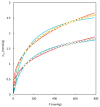S/N/O-Enriched Carbons from Polyacrylonitrile-Based Block Copolymers for Selective Separation of Gas Streams
- PMID: 38257068
- PMCID: PMC10819996
- DOI: 10.3390/polym16020269
S/N/O-Enriched Carbons from Polyacrylonitrile-Based Block Copolymers for Selective Separation of Gas Streams
Abstract
A series of polyacrylonitrile (PAN)-based block copolymers with poly(methyl methacrylate) (PMMA) as sacrificial bock were synthesized by atom transfer radical polymerization and used as precursors for the synthesis of porous carbons. The carbons enriched with O- and S-containing groups, introduced by controlled oxidation and sulfuration, respectively, were characterized by Raman spectroscopy, scanning electron microscopy, and X-ray photoelectron spectrometry, and their surface textural properties were measured by a volumetric analyzer. We observed that the presence of sulfur tends to modify the structure of the carbons, from microporous to mesoporous, while the use of copolymers with a range of molar composition PAN/PMMA between 10/90 and 47/53 allows the obtainment of carbons with different degrees of porosity. The amount of sacrificial block only affects the morphology of carbons stabilized in oxygen, inducing their nanostructuration, but has no effect on their chemical composition. We also demonstrated their suitability for separating a typical N2/CO2 post-combustion stream.
Keywords: atom transfer radical polymerization; block copolymer templates; hierarchical pores; oxidative-stabilization; sulfur-doping.
Conflict of interest statement
The authors declare no conflicts of interest.
Figures













References
-
- Lodge T.P. Block Copolymers: Long-Term Growth with Added Value. Macromolecules. 2020;53:2–4. doi: 10.1021/acs.macromol.9b02069. - DOI
-
- Bodratti A.M., Alexandridis P. Amphiphilic Block Copolymers in Drug Delivery: Advances in Formulation Structure and Performance. Expert Opin. Drug Deliv. 2018;15:1085–1104. - PubMed
-
- Liu T., Liu G. Block Copolymer-Based Porous Carbons for Supercapacitors. J. Mater. Chem. A. 2019;7:23476–23488. doi: 10.1039/C9TA07770G. - DOI
Grants and funding
LinkOut - more resources
Full Text Sources

